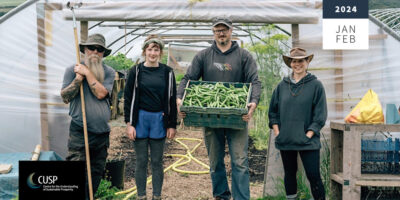Learning to work differently: reflections on transdisciplinary research
Conducting research that integrates and broadens insights and approaches from multiple perspectives is essential for tackling the complexities of system change. In the inaugural blog of our new series, Kate Burningham reflects on some practical implications of transdisciplinarity for academic work practices.
Blog by Kate Burningham

What does transdisciplinary research involve in practice? What aspects of everyday work does it require us to rethink?
Researchers from the Universities of Surrey and Middlesex and Shared Assets CIC are studying the role of social enterprises as catalysts for sustainable and healthy local food systems. We are a transdisciplinary team with specialisms in social enterprise, sustainable consumption, food and land justice, nutrition and environmental life cycle assessment and are working closely with six diverse social enterprises. Research that combines and extends insights and approaches from multiple perspectives is crucial for effectively addressing the challenge of transforming food systems.
In our new series of blogs, we reflect on some of the realities of how we are working together, what we are learning, and what the difficulties and joys of trying to work in a transdisciplinary way are.
Writing the blogs is part of our process of collective self-reflection, but we hope that they will also be useful for others interested in transdisciplinary collaboration. Blogs will be written from different project members’ perspectives, and each explore various aspects of the project.
Although transdisciplinarity assumes equal collaboration, academic partners usually hold significant power and influence: funding tends to be held at universities, institutional protocols for ethics and governance shape research approaches and academic working practices may go unquestioned.
I am a sociologist by training and in this first blog will share some of what I learnt in discussions and meetings with our partner Shared Assets in the first months of the project. I’ve identified the following principles that emphasise the necessity for a more diverse work approach.
1. Work out how to communicate.
Within our universities, email is the default form of communication and Microsoft Teams the prescribed platform for online meetings and sharing documents. We began the project without considering whether these were going to work well. It quickly turned out to be a problem. Shared Assets did not have Microsoft—whenever we sent documents they had to download and convert the format. In addition, Microsoft Teams is a finely tuned and enclosed environment, it can be tricky for those based outside the University in which the Teams folder has been created to access these files. As a ‘think and do tank’, Shared Assets prefers to use the productivity platform Slack for project updates rather than email. We now understand each other’s different preferred platforms for communication and have workable—if not perfect—solutions.
We are using Zoom for our online meetings and NextCloud for sharing project documents. NextCloud allows us to create secure partitions within the cloud, granting access only to designated individuals. This feature ensures the safe sharing of specific files, aligning with the stringent data protection standards mandated by our universities. Additionally, it streamlines the process of sharing documents among multiple organisations.
We are still relying on email—so far, most university researchers have resisted additional communication channels—but this might change…
2. Clarify responsibilities and tasks.
In early meetings and correspondence, Shared Assets staff often sought clarification about their role in specific aspects of the project. For the project bid, we had put team members’ names alongside specific ‘work packages’ and for each university researcher we had budgeted number of hours to be charged to the grant over the duration of the grant while for Shared Assets we had budgeted total numbers of days. While for those working within permanent university contracts some flexibility was possible between time spent on this project and other contractual and research commitments, for Shared Assets (a not for profit organisation working on a tight budget) and for contracted researchers (balancing this project alongside others)—certainty about what exactly each aspect of the project required and how much time could be spent on it was essential.
3. Be clear about objectives of meetings.
Academics are used to scheduling regular meetings throughout projects and drafting predictable agendas with reports on actions against minutes of previous meetings and updates from those leading work packages. We don’t always think clearly about why we are meeting and what the meeting could achieve. When we were planning our first face-to-face meeting, Shared Assets challenged us on this. In line with their need for clarity about what time they were spending on the project and for what purpose, meetings without clear objectives were unwelcome. Shared Assets took on responsibility for planning the agenda of our face-to-face meeting and transformed our approach profoundly. This included that from now on, on the top of the agenda, our meeting objectives were spelt out. ‘Get to know each other better’ being the main purpose of the first one, and ‘Understand our preferred ways of working’ the second one—which leads to my final principle…
4. Prioritise the human aspects of team work.
One of the most enjoyable parts of working in project teams can be getting to know each other, but this is often left to chance, not designed purposefully into activities. Our first in-person meeting was designed to ensure everyone spoke and felt included from the start and engaged with how we were feeling about the project, not just with our plans and progress. Rather than long introductions about our professional backgrounds and related research we were all asked how we were feeling that morning and what we had had for breakfast. This was a non-threatening, inclusive and gently amusing activity. We then sketched out ‘user manuals’ for ourselves indicating when and how we worked best and shared these with each other. Splitting into small groups we discussed: our intentions for the project (what do we want to happen?); our concerns (what do we fear might go wrong?); project boundaries (what constraints are there?). And dreams: what would the best outcome look like? This enabled us to understand each other’s hopes and fears and where our perspectives on what we were doing were aligned or diverse. I have subsequently successfully used all of these activities in meetings for other research projects—they are fun, involve the whole team and open up important discussions that we would not otherwise have.
These principles now underpin how we work with Shared Assets and with the social enterprise partners. They may seem basic but are often neglected in our business-as-usual approach to research. Working in a transdisciplinary team is about recognising the flaws as well as the strengths in our established ways of doing things and learning how to do things differently.



